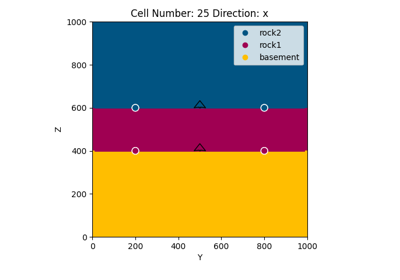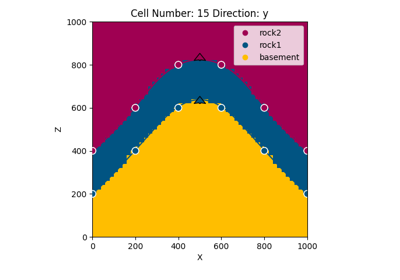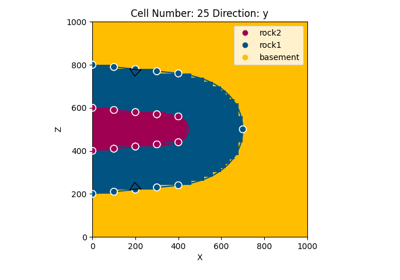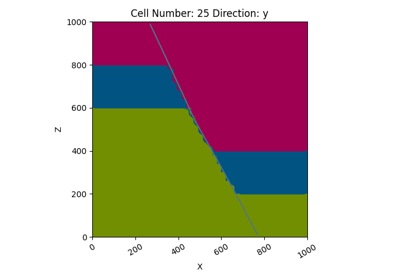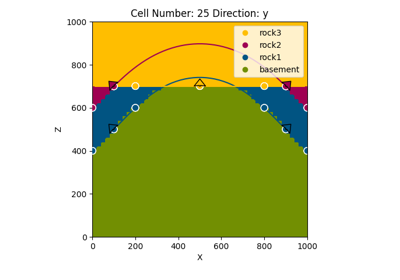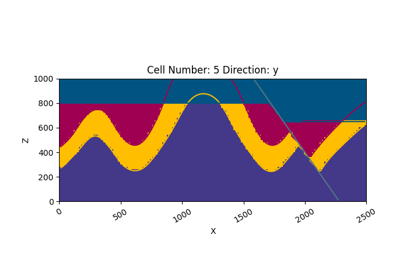gempy.core.interpolator.InterpolatorModel¶
-
class
gempy.core.interpolator.InterpolatorModel(surface_points: gempy.core.data_modules.geometric_data.SurfacePoints, orientations: gempy.core.data_modules.geometric_data.Orientations, grid: gempy.core.data.Grid, surfaces: gempy.core.data.Surfaces, series, faults: gempy.core.data_modules.stack.Faults, additional_data: gempy.core.data.AdditionalData, **kwargs)[source]¶ Child class of
Interpolatorwhich set the shared variables and compiles the theano graph to compute the geological model, i.e. lithologies.-
compute_weights_ctrl¶ [s0] List that controls what parts of the graph for each series have to be recomputed
- Interpolator Doc
- (inserted)
Class that act as:
linker between the data objects and the theano graph
container of theano graphs + shared variables
container of theano function
Args:
surface_points (SurfacePoints): [s0] Data child with specific methods to manipulate interface data. It is initialize without arguments to giveflexibility to the origin of the data.
orientations (Orientations): [s1] Data child with specific methods to manipulate orientation data. It is initialize without arguments to giveflexibility to the origin of the data.
grid (Grid): [s2] Class to generate grids.
surfaces (Surfaces): [s3] Class that contains the surfaces of the model and the values of each of them.
series (Series): [s4] Class that contains the functionality and attributes related to the series. Notice that series does not onlyrefers to stratigraphic series but to any set of surfaces which will be interpolated together (comfortably).
faults (Faults): [s5] Class that encapsulate faulting related content. Mainly, which surfaces/surfaces are faults. The fault network—i.e. which faults offset other faults—and fault types—finite vs infinite.
additional_data (AdditionalData): [s6] Container class that encapsulate
Structure,KrigingParameters,Optionsand rescaling parameterskwargs:
compile_theano: if true, the function is compile at the creation of the class
Attributes:
surface_points (SurfacePoints)
orientations (Orientations)
grid (Grid)
surfaces (Surfaces)
faults (Faults)
additional_data (AdditionalData)
dtype ([‘float32’, ‘float64’]): float precision
theano_graph: theano graph object with the properties from AdditionalData -> Options
theano function: python function to call the theano code
Examples using InterpolatorModel
Methods
__init__(surface_points, orientations, grid, …)Initialize self.
calculate_V(centered_grid)calculate_tz(centered_grid)compile_th_fn_geo([inplace, debug, grid])Compile and create the theano function which can be evaluated to compute the geological models
create_theano_graph([additional_data, …])Create the graph accordingly to the options in the AdditionalData object
get_python_input_block([append_control, …])Get values from the data objects used during the interpolation:
Modify all theano shared matrices to the right size according to the structure data.
Modify the theano shared weights vector according to the structure.
Print many of the theano shared variables
remove_series_without_data()Method to reset to the initial state all the recompute ctrl. After calling this method next time
set_all_shared_parameters([reset_ctrl])Set all theano shared parameters required for the computation of lithology
Initialize the ctrl vectors to the number of series size.
Initialize all the theano shared variables where we store the final results of the interpolation.
Initialize all the theano shared variables where we store the final results of the interpolation except the kriging weights vector.
set_theano_graph(th_graph)Attach an already create theano graph.
set_theano_shared_Vs_kernel([V])set_theano_shared_fault_relation()Set all theano shared variables wich controls the faults behaviour
set_theano_shared_gravity([tz, pos_density])set_theano_shared_grid([grid])Set theano shared variable which controls if a series is fault or not
Set theano shared variable which controls if a fault is finite or not
set_theano_shared_kriging()Set to the theano_graph attribute the shared variables of kriging values from the linked
set_theano_shared_l0_l1()Set the theano shared variables that are looped for each series.
set_theano_shared_magnetic_cts(incl, decl[, …])- param B_ext
External magnetic field in [T], in magnetic surveys this is the geomagnetic field - varies temporaly
set_theano_shared_magnetics([V, …])set_theano_shared_nuggets()Set the theano variables which control the masking patterns according to the uncomformity relation
set_theano_shared_pos_density(pos_density)set_theano_shared_pos_magnetics(pos_magnetics)Set all theano shared variables that control all the series interactions with each other
set_theano_shared_structure([reset_ctrl])Set all theano shared variable dependent on
Structure.set_theano_shared_structure_surfaces()Set to the theano_graph attribute the shared variables of structure from the linked
set_theano_shared_topology()set_theano_shared_tz_kernel([tz])Set the theano component tz to each voxel
Set the theano shared weights and [s0] Set the theano shared variables that are looped for each series
-
__init__(surface_points: gempy.core.data_modules.geometric_data.SurfacePoints, orientations: gempy.core.data_modules.geometric_data.Orientations, grid: gempy.core.data.Grid, surfaces: gempy.core.data.Surfaces, series, faults: gempy.core.data_modules.stack.Faults, additional_data: gempy.core.data.AdditionalData, **kwargs)[source]¶ Initialize self. See help(type(self)) for accurate signature.
-
reset_flow_control_initial_results(reset_weights=True, reset_scalar=True, reset_block=True)[source]¶ - Method to reset to the initial state all the recompute ctrl. After calling this method next time
gp.compute_model is called, everything will be computed. Panic bottom.
Set all theano shared parameters required for the computation of lithology
- Parameters
reset_ctrl (bool) – If true, [s0] Method to reset to the initial state all the recompute ctrl. After calling this method next time gp.compute_model is called, everything will be computed. Panic bottom.
- Returns
True
Set all theano shared variable dependent on
Structure.- Parameters
reset_ctrl (bool) – If true, [s0] Method to reset to the initial state all the recompute ctrl. After calling this method next time gp.compute_model is called, everything will be computed. Panic bottom.
- Returns
True
Set the theano shared variables that are looped for each series.
Set the theano shared weights and [s0] Set the theano shared variables that are looped for each series
Set theano shared variable which controls if a series is fault or not
Set theano shared variable which controls if a fault is finite or not
Set the theano variables which control the masking patterns according to the uncomformity relation
Set all theano shared variables wich controls the faults behaviour
Set all theano shared variables that control all the series interactions with each other
-
set_initial_results()[source]¶ Initialize all the theano shared variables where we store the final results of the interpolation. This function must be called always after set_theano_shared_loop
- Returns
True
-
set_initial_results_matrices()[source]¶ Initialize all the theano shared variables where we store the final results of the interpolation except the kriging weights vector.
- Returns
True
-
modify_results_matrices_pro()[source]¶ Modify all theano shared matrices to the right size according to the structure data. This method allows to change the size of the results without having the recompute all series
-
modify_results_weights()[source]¶ Modify the theano shared weights vector according to the structure.
-
get_python_input_block(append_control=True, fault_drift=None)[source]¶ - Get values from the data objects used during the interpolation:
dip positions XYZ
dip angles
azimuth
polarity
surface_points coordinates XYZ
Print many of the theano shared variables
-
compile_th_fn_geo(inplace=False, debug=True, grid: Optional[Union[str, numpy.ndarray]] = None)[source]¶ Compile and create the theano function which can be evaluated to compute the geological models
- Parameters
- Returns
function that computes the whole interpolation
- Return type
theano.function
-


